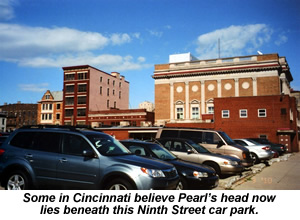 Six weeks later, with the building now flattened, Thomas could report no more than a false wooden floor his men had discovered and torn up, but found nothing beneath. Reporters gamely tried to keep the story alive by suggesting Jackson might have buried Pearl's head in the building's basement, in which case the wrecking crew's debris would just have added another layer to its cover. Perhaps, they hinted, the head now lay somewhere beneath DeCourcy's new parking lot.
Six weeks later, with the building now flattened, Thomas could report no more than a false wooden floor his men had discovered and torn up, but found nothing beneath. Reporters gamely tried to keep the story alive by suggesting Jackson might have buried Pearl's head in the building's basement, in which case the wrecking crew's debris would just have added another layer to its cover. Perhaps, they hinted, the head now lay somewhere beneath DeCourcy's new parking lot.
It may have been the demolition's coverage that inspired Bruce Buckley, a graduate student at Indiana University, to include Pearl Bryan on his 1954 album Ohio River Ballads. Like Doc Hopkins before him, Buckley used many of the Dalhart verses, but could not resist a few macabre additions of his own. First, he imports the Penguin verse about Pearl's grip carrying her head away, and then has Jackson and Walling practically dancing around her corpse with glee. Pearl's parents could not yet have suspected their daughter's fate, he sings, but:
How sad it would have been to them,
To have heard Pearl's lonely voice,
At midnight in that lonely spot,
Where those two boys rejoiced.
Finally, he allows Pearl's sister a little dignity in the begging scene by letting her speak for herself. As Mabel delivers the final two lines of this next verse, I always picture her climbing up from her knees, then turning away from Jackson to dismiss him with the contempt he deserves:
Scott Jackson set a stubborn jaw,
Not a word would he have said,
'I'll meet my sister in Heaven,
Where they'll find her missing head'.
The folksinger Paul Clayton included Buckley's "grip" verse on his own 1956 recording of Pearl Bryan, but I've heard only the fragment of Clayton's track preserved in the British Library's sound archive, so that's all I can vouch for there. By the time he put the song to disc, death had claimed a couple more of the figures in Pearl's story, including William Hamilton, one of the Cincinnati reporters who'd originally covered the case, and Dr Robert Carothers, who'd conducted Pearl's first autopsy. Both died in 1954.
Even if Hamilton had discovered a cure for cancer, I suspect the CP and the CE would have headlined their obituaries with a Pearl Bryan reference anyway. Neither paper disappointed, going for "Ex-reporter's death recalls Pearl Bryan" and "Death Takes Reporter in Bryan Murder Case" respectively. (64, 65)
My library search failed to turn up a formal obituary for Dr Carothers, but I do know he left behind a typed memoir setting out his recollections of the case. I've already quoted from this document above, which was discovered when someone went through the late doctor's effects. We don't know exactly when Carothers wrote it, but it borrows a couple of phrases verbatim from Crim's 1946 account, so he must have produced it some time in the final eight years of his life.
Carothers' memoir was published for the first time in the CP's May 2, 1956, editon, by which time people were ready to make lighter of Pearl's story than ever. Now she was described as "the village maiden who literally lost her head in the city". Even when they made jokes about Pearl, it seems, the papers were determined to slot her into the city-v-country dichotomy they'd always observed as part of the "murdered girl" template.
There was a steady dribble of minor Pearl Bryan stories throughout the 1960s, including John Lock's decision to sell his Dad's old farmhouse in 1962, a new recording of Pearl's ballad by Doc Hopkins' disciple Fleming Brown in the same year, and the 1966 death of a newspaper illustrator who'd once drawn her headless body. The first of these developments proved more significant that anyone could have guessed at the time, because it paved the way for John Mendell and his wife Cyndi to buy the Lock farmhouse 15 years later. If that purchase hadn't persuaded John to investigate Pearl's story for himself, the valise which once carried her head might have been lost forever.